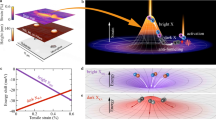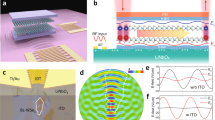Abstract
Two-dimensional transition metal dichalcogenides provide an attractive platform for studying strain-dependent exciton transport at room temperature due to large exciton binding energy and strong bandgap sensitivity to mechanical stimuli. Here we use Rayleigh-type surface acoustic waves to demonstrate controlled and directional exciton transport under the weak coupling regime at room temperature. We screen the in-plane piezoelectric field using photogenerated carriers to study transport under type-I bandgap modulation and measure a maximum exciton drift velocity of 600 m s–1. Furthermore, we demonstrate the precise steering of exciton flux by controlling the relative phase between the input RF excitation and exciton photogeneration. The results provide an important insight into the weak coupling regime between the dynamic strain wave and room-temperature excitons in a two-dimensional semiconductor system and pave the way to exciting applications of excitonic devices ranging from data communication and processing to sensing and energy conversion.
This is a preview of subscription content, access via your institution
Access options
Access Nature and 54 other Nature Portfolio journals
Get Nature+, our best-value online-access subscription
$29.99 / 30 days
cancel any time
Subscribe to this journal
Receive 12 print issues and online access
$209.00 per year
only $17.42 per issue
Buy this article
- Purchase on Springer Link
- Instant access to full article PDF
Prices may be subject to local taxes which are calculated during checkout




Similar content being viewed by others
Data availability
The raw dataset from phase-synchronized diffusion measurements and CW PL measurements are available from the corresponding author upon reasonable request.
Code availability
The code for processing the raw TCSPC data is available from the corresponding author upon reasonable request.
References
Scholes, G. D. Long-range resonance energy transfer in molecular systems. Annu. Rev. Phys. Chem. 54, 57–87 (2003).
Tan, T. et al. 2D material optoelectronics for information functional device applications: status and challenges. Adv. Sci. 7, 2000058 (2020).
Rose, A., Zhu, Z., Madigan, C. F., Swager, T. M. & Bulović, V. Sensitivity gains in chemosensing by lasing action in organic polymers. Nature 434, 876–879 (2005).
Butov, L. V. Excitonic devices. Superlattices Microstruct. 108, 2–26 (2017).
Grosso, G. et al. Excitonic switches operating at around 100 K. Nat. Photon. 3, 577–580 (2009).
Manzeli, S., Ovchinnikov, D., Pasquier, D., Yazyev, O. V. & Kis, A. 2D transition metal dichalcogenides. Nat. Rev. Mater. 2, 17033 (2017).
Chernikov, A. et al. Exciton binding energy and nonhydrogenic Rydberg series in monolayer WS2. Phys. Rev. Lett. 113, 076802 (2014).
Fowler-Gerace, L. H., Choksy, D. J. & Butov, L. V. Voltage-controlled long-range propagation of indirect excitons in van der Waals heterostructure. Phys. Rev. B 104, 165302 (2021).
Moon, H. et al. Dynamic exciton funneling by local strain control in a monolayer semiconductor. Nano Lett. 20, 6791–6797 (2020).
Cordovilla Leon, D. F., Li, Z., Jang, S. W., Cheng, C. H. & Deotare, P. B. Exciton transport in strained monolayer WSe2. Appl. Phys. Lett. 113, 252101 (2018).
High, A. A., Novitskaya, E. E., Butov, L. V., Hanson, M. & Gossard, A. C. Control of exciton fluxes in an excitonic integrated circuit. Science 321, 229–231 (2008).
Chaves, A. et al. Bandgap engineering of two-dimensional semiconductor materials. npj 2D Mater. Appl. 4, 29 (2020).
Unuchek, D. et al. Room-temperature electrical control of exciton flux in a van der Waals heterostructure. Nature 560, 340–344 (2018).
Jiang, Y., Chen, S., Zheng, W., Zheng, B. & Pan, A. Interlayer exciton formation, relaxation, and transport in TMD van der Waals heterostructures. Light Sci. Appl. 10, 72 (2021).
Unuchek, D. et al. Valley-polarized exciton currents in a van der Waals heterostructure. Nat. Nanotechnol. 14, 1104–1109 (2019).
Rudolph, J., Hey, R. & Santos, P. V. Long-range exciton transport by dynamic strain fields in a GaAs quantum well. Phys. Rev. Lett. 99, 047602 (2007).
Violante, A. et al. Dynamics of indirect exciton transport by moving acoustic fields. New J. Phys. 16, 033035 (2014).
Lazić, S. et al. Scalable interconnections for remote indirect exciton systems based on acoustic transport. Phys. Rev. B 89, 085313 (2014).
Jing, Y. et al. Tunable electronic structure of two-dimensional transition metal chalcogenides for optoelectronic applications. Nanophotonics 9, 1675–1694 (2020).
Peng, Z., Chen, X., Fan, Y., Srolovitz, D. J. & Lei, D. Strain engineering of 2D semiconductors and graphene: from strain fields to band-structure tuning and photonic applications. Light Sci. Appl. 9, 190 (2020).
Bandhu, L., Lawton, L. M. & Nash, G. R. Macroscopic acoustoelectric charge transport in graphene. Appl. Phys. Lett. 103, 133101 (2013).
Miseikis, V., Cunningham, J. E., Saeed, K., O’Rorke, R. & Davies, A. G. Acoustically induced current flow in graphene. Appl. Phys. Lett. 100, 133105 (2012).
Zhou, P., Chen, C., Wang, X., Hu, B. & San, H. 2-Dimentional photoconductive MoS2 nanosheets using in surface acoustic wave resonators for ultraviolet light sensing. Sens. Actuator. A Phys. 271, 389–397 (2018).
Fandan, R. et al. Dynamic local strain in graphene generated by surface acoustic waves. Nano Lett. 20, 402–409 (2019).
Rezk, A. R. et al. Acoustic–excitonic coupling for dynamic photoluminescence manipulation of quasi-2D MoS2 nanoflakes. Adv. Opt. Mater. 3, 888–894 (2015).
Datta, K., Li, Z., Lyu, Z. & Deotare, P. B. Piezoelectric modulation of excitonic properties in monolayer WSe2 under strong dielectric screening. ACS Nano 15, 12334–12341 (2021).
Hoshi, Y. et al. Suppression of exciton-exciton annihilation in tungsten disulfide monolayers encapsulated by hexagonal boron nitrides. Phys. Rev. B 95, 241403 (2017).
Dean, C. R. et al. Boron nitride substrates for high-quality graphene electronics. Nat. Nanotechnol. 5, 722–726 (2010).
Wierzbowski, J. et al. Direct exciton emission from atomically thin transition metal dichalcogenide heterostructures near the lifetime limit. Sci. Rep. 7, 12383 (2017).
Hotta, T. et al. Exciton diffusion in a hBN-encapsulated monolayer MoSe2. Phys. Rev. B 102, 115424 (2020).
Lin, Y. et al. Dielectric screening of excitons and trions in single-layer MoS2. Nano Lett. 14, 5569–5576 (2014).
Santos, P. V., Ramsteiner, M. & Jungnickel, F. Spatially resolved photoluminescence in GaAs surface acoustic wave structures. Appl. Phys. Lett. 72, 2099–2101 (1998).
Morgan, D. Surface Acoustic Wave Filters (Elsevier, 2007).
García-Cristóbal, A., Cantarero, A., Alsina, F. & Santos, P. V. Spatiotemporal carrier dynamics in quantum wells under surface acoustic waves. Phys. Rev. B 69, 205301 (2004).
Aas, S. & Bulutay, C. Strain dependence of photoluminescence and circular dichroism in transition metal dichalcogenides: a k·p analysis. Opt. Express 26, 28672–28681 (2018).
Shur, V. Y. Lithium niobate and lithium tantalate-based piezoelectric materials. in Advanced Piezoelectric Materials: Science and Technology 204–238 (Elsevier, 2010).
Gärtner, A., Holleitner, A. W., Kotthaus, J. P. & Schuh, D. Drift mobility of long-living excitons in coupled GaAs quantum wells. Appl. Phys. Lett. 89, 52108 (2006).
Dorow, C. J. et al. High-mobility indirect excitons in wide single quantum well. Appl. Phys. Lett. 113, 212102 (2018).
Falin, A. et al. Mechanical properties of atomically thin boron nitride and the role of interlayer interactions. Nat. Commun. 8, 15815 (2017).
Mueller, T. & Malic, E. Exciton physics and device application of two-dimensional transition metal dichalcogenide semiconductors. npj 2D Mater. Appl. 2, 29 (2018).
Feierabend, M., Morlet, A., Berghäuser, G. & Malic, E. Impact of strain on the optical fingerprint of monolayer transition-metal dichalcogenides. Phys. Rev. B 96, 045425 (2017).
Feng, J., Qian, X., Huang, C. W. & Li, J. Strain-engineered artificial atom as a broad-spectrum solar energy funnel. Nat. Photon. 6, 866–872 (2012).
Harats, M. G., Kirchhof, J. N., Qiao, M., Greben, K. & Bolotin, K. I. Dynamics and efficient conversion of excitons to trions in non-uniformly strained monolayer WS2. Nat. Photon. 14, 324–329 (2020).
Kovalchuk, S. et al. Neutral and charged excitons interplay in non-uniformly strain-engineered WS2. 2D Mater. 7, 035024 (2020).
Rudolph, J., Hey, R. & Santos, P. V. Exciton transport by surface acoustic waves. Superlattices Microstruct. 41, 293–296 (2007).
Perea-Causín, R. et al. Exciton propagation and halo formation in two-dimensional materials. Nano Lett. 19, 7317–7323 (2019).
Miller, D. A. B. et al. Electric field dependence of optical absorption near the band gap of quantum-well structures. Phys. Rev. B 32, 1043–1060 (1985).
Aslan, O. B., Deng, M. & Heinz, T. F. Strain tuning of excitons in monolayer WSe2. Phys. Rev. B 98, 115308 (2018).
Castellanos-Gomez, A. et al. Deterministic transfer of two-dimensional materials by all-dry viscoelastic stamping. 2D Mater. 1, 011002 (2014).
Acknowledgements
We acknowledge the help and support from the Lurie Nanofabrication Facility at the University of Michigan, Ann Arbor, where the device fabrication was carried out. P.B.D. acknowledges partial support of this work by the Air Force Office of Scientific Research (AFOSR) award no. FA9550-17-1-0208 and by the Army Research Office under grant no. W911NF-21-1-0207. K.W. and T.T. acknowledge support from the Elemental Strategy Initiative conducted by the MEXT, Japan (grant no. JPMXP0112101001), and JSPS KAKENHI (grant nos. 19H05790, 20H00354 and 21H05233).
Author information
Authors and Affiliations
Contributions
P.B.D. conceived the idea and supervised the project. K.D. fabricated and characterized the devices. Z.Lyu transferred the encapsulated monolayers on the SAW devices. P.B.D., K.D. and Z.Li. analysed the data. Growth of hBN was done by T.T. and K.W. P.B.D., K.D. and Z.Li. contributed to writing the manuscript.
Corresponding author
Ethics declarations
Competing interests
The authors declare no competing interests.
Peer review
Peer review information
Nature Photonics thanks Andres Castellanos-Gomez and the other, anonymous, reviewer(s) for their contribution to the peer review of this work.
Additional information
Publisher’s note Springer Nature remains neutral with regard to jurisdictional claims in published maps and institutional affiliations.
Supplementary information
Supplementary Information
Supplementray Figs. 1–19, Sections 1–13 and Table 1.
Rights and permissions
About this article
Cite this article
Datta, K., Lyu, Z., Li, Z. et al. Spatiotemporally controlled room-temperature exciton transport under dynamic strain. Nat. Photon. 16, 242–247 (2022). https://doi.org/10.1038/s41566-021-00951-3
Received:
Accepted:
Published:
Issue Date:
DOI: https://doi.org/10.1038/s41566-021-00951-3
This article is cited by
-
Excitons surf the waves
Nature Photonics (2022)



